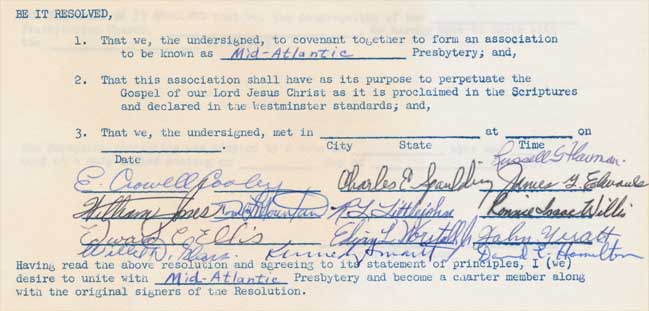Both a Lawyer and a Pastor
Robert Reid Howison was born on 22 June 1820. His parent’s names are not recorded in the PCUS Ministerial Directory. Howison studied at the Fredericksburg Academy and then studied law privately before being admitted to the bar in 1841. He then entered the Union Theological Seminary in Richmond, VA, attending there from 1841-1843. Robert was licensed to preach on 27 April 1844 by East Hanover Presbytery and then ordained to the ministry on 4 October 1844 by Lexington Presbytery, being installed as pastor of the Presbyterian church in Staunton, Virginia, where he served from 1844-1845.
Ill health prompted him to be divested of office at his own request in October of 1845, and he resumed his legal practice, serving in that capacity from 1846-1870. He practiced law for many years in Richmond in the years leading up to the Civil War, and was engaged in a case held in the old capital building, when the floor of the building collapsed, and he was buried beneath the rubble. That injury left him recuperating for about three years, and it was 1873 before he returned to legal practice. He continued in that capacity until 1880, at which time re-entered the ministry, with renewal of his license to preach, under the authority of East Hanover Presbytery, in April of 1880.
He was re-ordained on 15 April 1881, also under the authority of East Hanover, and installed as pastor of the Samuel Davies Presbyterian Church, serving there from 1881-1883. He next answered a call to serve the Third Presbyterian Church in Richmond, VA, from 1883-1889, and then served as Stated Supply for the churches of Culpepper, Orange and Milder, 1889-1894,, and the Presbyterian church in Ashland, 1894 until retirement in 1903.
Rev. Howison was also a professor of American history at Fredericksburg College from 1894 until his death in 1906. He died on Tuesday morning, November 1, 1906 at his home in Fredericksburg, Virginia, at the age of 87. Honors bestowed during his life include the LL.D. degree, conferred by Hampden-Sydney College in 1897. He was as well an accomplished historian, having written a valuable history of Virginia and many other works of literature.
Chronological bibliography—
1846
A history of Virginia : from its discovery and settlement by Europeans to the present time (Philadelphia : Carey & Hart, 1846-1848), 2 v. ; 22 cm. Contents include: vol. 1. Containing the history of the colony to the peace of Paris, in 1763; vol. 2. Containing the history of the colony and of the state from 1763 to the retrocession of Alexandria in 1847, with a review of the present condition of Virginia. Imprint of v. 2: Richmond : Drinker and Morris ; New York ; London : Wiley and Putnam, 1848. [HP #1533]
Vol. 1 online at http://digital.library.pitt.edu/cgi-bin/t/text/text-idx?c=darltext;view=toc;idno=31735054780162
Vol. 2 online at http://digital.library.pitt.edu/cgi-bin/t/text/text-idx?c=darltext;view=toc;idno=31735054780204
1851
Reports of criminal trials in the circuit, state and United States courts, held in Richmond, Virginia. Richmond, Va.: G.M. West & Brother, 1851), 120 p. Reprinted, New York, 1937. And again reprinted as Howison’s Criminal trials of Virginia. Buffalo, N.Y.: Dennis, 1950, 1851. Online at http://www.heinonline.org/HOL/Index?index=trials/hwison&collection=trials
1857
Cowan, Virginia M., An essay on “The world as it is” S.l.: s.n., 1857. Written by Virginia M. Cowan of Memphis, Tennessee, and read by R.R. Howison, Esq., at the commencement of the Richmond Female Institute, June 26th, 1857.
1862-1864
“History of the War.” 1834-1864, Article [v. 1-2, chapter 1], appearing in The Southern Literary Messenger. Richmond, Va.: 1834ff.
1871
Mutual Benefit Life In. Co. vs. Atwood’s administratrix. D.M.–31 A. Richmond, Va., 1871. 33 p.
1880
Fredericksburg: past, present and future. Fredericksburg, VA: R.B. Merchant, 1880. 52 p. Reprinted, Fredericksburg, VA: J. Willard Adams, 1898. New ed., with supplement, 80 p.
1883
God and Creation. Richmond, VA: West, Johnston & co., 1883. 578 p.
“The New Testament Plan of Educating Candidates for the Christian Ministry,” in The Southern Presbyterian Review, 34.4 (October 1883): 651-682.
1887
Howison, Robert R., George D. Armstrong and Hugh Blair, Historical sketch of the Presbytery of East Hanover, Virginia. Richmond, VA: Whittet & Shepperson, 1887. 17 p.
1892
A history of the United States of America. Intended for students in schools, academies, colleges, universities and at home, and for general readers. Richmond, VA: Everett Waddey Co., 1892. 936 p.
Posthumous Publications—
1922
“Fredericksburg: Her People and Characters,” in The William and Mary Quarterly, 2nd Series, 2.4 (October 1922): 221-238.
1924
“Dueling in Virginia,” in The William and Mary College Quarterly Historical Magazine, 2nd Series, 4.4 (October 1924): 217-244.
Works concerning Robert R. Howison—
Stephens, Trina A. Jr., Twice Forty Years Of Learning: An Educational Biography of Robert Reid Howison (1820-1906); Ph.D. dissertation, available online at http://scholar.lib.vt.edu/theses/available/etd-51998-15534/


